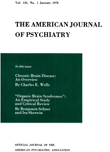Abstract
This study demonstrates statistically in an unselected group of 100 male patients the frequent favorable influence of intercurrent physical disorders upon the course of mental illness. Not infrequently, as seen in II percent of the patients, the physical illness appears to precipitate recovery. The analysis of the 100 cases has revealed that the age of the patient is of little or no significance. The duration of the mental illness prior to the appearance of the physical disorder, however, does appear to have significance; of those hospitalized less than one year, 75 percent revealed improvement, while in those hospitalized for mental illness over one year, only 40 percent showed improvement following intercurrent physical disorder. Personality factors, whether of aggressive or passive type as judged by outward behavior appeared from this study to have little or no influence on the reaction to physical disorder. In contrasting the two most frequently observed trends it was observed that improvement was more consistently associated with a depressive trend than with a persecutory trend.
Accidental or self-inflicted injuries proved to be a stimulus for improvement in a high proportion of patients. There were 9 self-inflicted and 13 accidental injuries making a total of 22 patients injured, with improvement occurring in 18 instances or in over 85 percent of these patients. The patients with self-inflicted injuries did somewhat better as a group than those with accidental injuries.
Generally speaking, these patients who showed mental improvement in relation to physical disorder also did so with shock treatment although a substantial number improved with shock treatment who did not do so with intercurrent physical illness. In those who showed a capacity for improvement in response to both shock therapy and physical disorder, the prospect of sustained improvement or recovery was better than in those who were improved in relation to physical illness alone or shock therapy alone.
A total of 67 of the 100 cases showed improvement following intercurrent physical disorder, with the improvement proceeding directly to recovery in 11 patients. The most striking and consistent change appeared in the 34 manic-depressive cases, with improvement in 26 instances. The manic-depressive depressed group, however, did the best with 14 out of 15 showing improvement. The patients who already had organic brain disease, as might be expected, did least well in relation to intercurrent physical illness with 2 out of 8 made mentally worse.
This study of a group of 100 patients definitely suggests that one factor determining the mental improvement often associated with intercurrent physical disorder is a stimulation of the patient's interest toward the realistic goal of recovery through a threat to his physical existence. It is as if the aggression and interest which is withdrawn from external reality and turned inward into the relatively useless fabric of mental illness can often be organized and more realistically directed outward by the patient confronted by the fear of death which is phylogenetically perhaps his most fundamental concern. For this reason it might be expected that even the most chronically regressed mental patients may show a definite temporary mental improvement associated with physical illness while more acutely ill patients may be stimulated into recovery. It might also be anticipated as our results show, that the interest of the manic-depressive, depressive, patients whose aggression appears so relatively well organized even though turned inward, could most easily be turned back into external reality with a resulting high rate of improvement or recovery.
A comparison of the mental responses of the patients who also had shock treatment suggests that the improvement found in association with intercurrent physical illness, as well as with the manipulations of shock treatment, may have the factor in common of providing a threat to the patient which stimulates the organization of his capacities in a striving toward the biologically fundamental direction of recovery.

